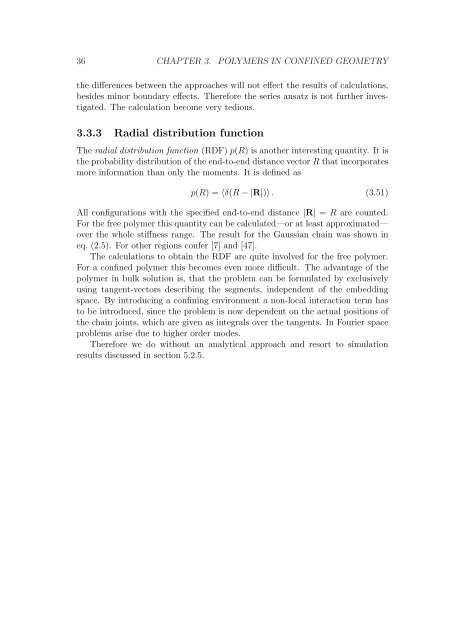Polymers in Confined Geometry.pdf
Polymers in Confined Geometry.pdf
Polymers in Confined Geometry.pdf
Create successful ePaper yourself
Turn your PDF publications into a flip-book with our unique Google optimized e-Paper software.
36 CHAPTER 3. POLYMERS IN CONFINED GEOMETRY<br />
the differences between the approaches will not effect the results of calculations,<br />
besides m<strong>in</strong>or boundary effects. Therefore the series ansatz is not further <strong>in</strong>vestigated.<br />
The calculation become very tedious.<br />
3.3.3 Radial distribution function<br />
The radial distribution function (RDF) p(R) is another <strong>in</strong>terest<strong>in</strong>g quantity. It is<br />
the probability distribution of the end-to-end distance vector R that <strong>in</strong>corporates<br />
more <strong>in</strong>formation than only the moments. It is def<strong>in</strong>ed as<br />
p(R) = 〈δ(R − |R|)〉 . (3.51)<br />
All configurations with the specified end-to-end distance |R| = R are counted.<br />
For the free polymer this quantity can be calculated—or at least approximated—<br />
over the whole stiffness range. The result for the Gaussian cha<strong>in</strong> was shown <strong>in</strong><br />
eq. (2.5). For other regions confer [7] and [47].<br />
The calculations to obta<strong>in</strong> the RDF are quite <strong>in</strong>volved for the free polymer.<br />
For a conf<strong>in</strong>ed polymer this becomes even more difficult. The advantage of the<br />
polymer <strong>in</strong> bulk solution is, that the problem can be formulated by exclusively<br />
us<strong>in</strong>g tangent-vectors describ<strong>in</strong>g the segments, <strong>in</strong>dependent of the embedd<strong>in</strong>g<br />
space. By <strong>in</strong>troduc<strong>in</strong>g a conf<strong>in</strong><strong>in</strong>g environment a non-local <strong>in</strong>teraction term has<br />
to be <strong>in</strong>troduced, s<strong>in</strong>ce the problem is now dependent on the actual positions of<br />
the cha<strong>in</strong> jo<strong>in</strong>ts, which are given as <strong>in</strong>tegrals over the tangents. In Fourier space<br />
problems arise due to higher order modes.<br />
Therefore we do without an analytical approach and resort to simulation<br />
results discussed <strong>in</strong> section 5.2.5.













